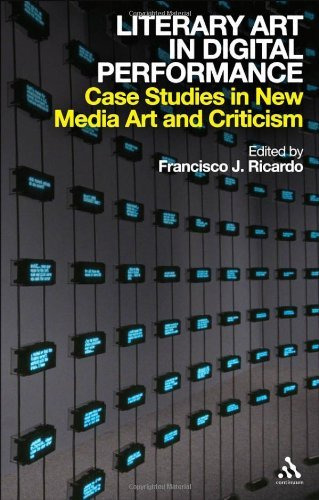Literary Art in Digital Performance: Case Studies in New Media Art and Criticism
Literary Art in Digital Performance examines electronic works of literary art, a category integrating the visual+textual including interactive poetry, narrative computer games, filmic sculpture, projective art, and other works specific to digital media. In recent decades, electronic art's aesthetic has been driven by new algorithmic, randomized, and emergent processes. Although this new art differs from material art or print literature, the rise of popular fascination with new media has neglected signifcant discussion of how technical mediation impacts contemporary art and literature. Presented as a collection of case studies by leading scholars, the book provides a contemporary optic on this art's forms, problems, and possibilities. Each case study is followed by a post-chapter dialogue where the editor engages authors on the foundational aesthetics of new media art and literature.
Table of Contents
1. Introduction: Juncture and Form in New Media Criticism, Francisco J. Ricardo
2. What is and Toward What End do We Read Digital Literature?, Roberto Simanowski Post-Chapter Dialogue, Simanowski and Ricardo
3. List(en)ing Post, Rita Raley Post-Chapter Dialogue, Raley and Ricardo
4. Strickland and Lawson Jaramillo’s Slippingglimpse: Distributed Cognition at/in Work, N. Katharine Hayles Post-Chapter Dialogue, Hayles and Ricardo
5. Reading Discursive Spaces of Text Rain, Transmodally, Francisco J. Ricardo
6. Kissing the Steak: The poetry of text generators, Christopher T. Funkhouser Post-Chapter Dialogue, Funkhouser and Ricardo
7. Geopoetics: Aesthetic Experience in the Works of Stefan Schemat and Teri Rueb, Katja Kwastek Post-Chapter Dialogue, Kwastek and Ricardo
8. Self, Setting, and Situation in Second Life, Maria Bäcke Post-Chapter Dialogue, Bäcke and Ricardo
9. Looking Behind the Façade: Playing and Performing an Interactive Drama, Jorgen Schäfer Post-Chapter Dialogue, Schäfer and Ricardo
10. Artificial Poetry: On Aesthetic Perception in Computer-Aided Literature, Peter Gendolla Post-Chapter Dialogue, Gendolla and Ricardo
11. Screen Writing: A Practice-based, EuroRelative Introduction to Digital Literature and Poetics, John Cayley Post-Chapter Dialogue, Cayley and Ricardo
If a name could convey the fusion of literature and art beyond media, it would connect to earlier traditions that harbored the same aesthetic and poetic aspirations.
...despite these essays' general aversion to affirming underlying conditions of art or literature, often remaining largely within situational description, there are nonetheless strong traces of thematic constitution of experience which, being theatrical, literary, poetic, or aesthetic, beg the question of what common conditions allow such experience to acquire this character.
...in this balance of authorial predisposition, toward which logic or tradition does the preponderance of media art theory appear to be leaning? In electronic art and literature, the answer depends upon whether one's critical gaze falls on the aesthetic mechanism of an electronic work, or on the aesthetic experience of what it generates.
When the common word in the oft-used terms, 'work of art' or 'literary work' becomes reference to a verb, rather than an object, its signified must be regarded as both.
Neither indexical, nor instrumental, nor of figuration, although assuming all of these directions, the digital work of art rather uses its anti-realist form as argument for metaphoricality, for a way of thinking about post-industrial being in relationship to persistent shifts and realignments, conceptually comparable to the way that contemporary art selects the signs implied by the materials and objects that it, too, exploits for that function.
Contents (Critical Writing):
Critical writing that references this:
| Title | Author | Publisher | Year |
|---|---|---|---|
| Aesthetic Animism: Digital Poetry as Ontological Probe | David Jhave Johnston | 2011 |


